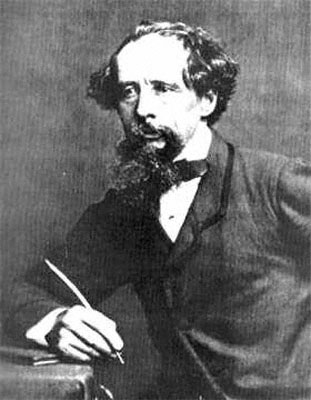
Background questions —
Charles Dickens,
A Christmas Carol
Listed below are 13 questions or topics, each connected with A Christmas Carol. Each of these is intended to lead you to particular sorts of information that will be useful for seeing A Christmas Carol as a work that reflects its times and some of the issues that characterized the culture of the times.
If you do outside research (which you probably will do)
in order to find answers to any or all of these questions, please bring to class
with you a list of all the research sources you consulted, itemized and alphabetized
in an appropriate fashion, with full information on author, title, publisher,
dates, and relevant pages.
1. What is Scrooge's occupation, and what do we know about businessmen of his sort in the London of 1843?
2. When asked for a charitable contribution, Scrooge says, "Are there no prisons?"
What were the conditions in prisons in and around London in the early 1840s?
And for what sort of things could people be imprisoned (or executed)?
3. When asked for a charitable contribution, Scrooge asks whether the "Union
workhouses" are still in operation. What is meant by "Union workhouses," who
inhabited them, and what were the conditions in such places in and around London
in the early 1840s?
4. In declining to contribute to charity, Scrooge mentions "the Treadmill" and
"the Poor Law." What were these, what was their function, and what were their
chief effects or consequences in the London of the early 1840s?
5. What do we know about men like Bob Cratchit in the London of 1843? What were
their "prospects" in life? Their limitations? Their origins and working conditions?
6. The Cratchits have a rather large number of children, considering their modest
circumstances. What sort of home life, schooling, and "opportunities" would
children like the Cratchits' children have had in 1843 London?
7. We are told that Martha Cratchit works as "a poor apprentice at a milliner's."
What were the opportunities for work at such establishments, and the working
conditions there, for girls of her age and circumstances in 1843 London?
8. What is wrong with Tiny Tim? And what would have been his opportunities for
treatment and his chances of survival (or recovery) in the London of 1843?
9. What can we determine about childhood diseases and the child mortality rates
in London during the early 1840s? Were things better there than in the country,
or worse, and why?
10. What can we determine about living conditions in London in 1843, both for
people like the Cratchits and for those like Scrooge? How about for those like
Nephew Fred?
11. What did Dickens' 1843 readers believe about the nature and function of
"Spirits" like the three that visit Scrooge?
12. What was the contemporary reception of A Christmas Carol? What
was its primary audience in 1843?
13. What aspects of Dickens' own childhood, education, and life experience are
reflected in A Christmas Carol?

Charles Dickens

Charles Dickens. From a daguerreotype, c. 1853
Some Internet Resources
David Perdue's Charles Dickens Page. This award-winning website offers a wealth of information on Dickens' life, works, and cultural milieu. It is an excellent starting-point for surfing the world of Dickens. There is an excellent page on illustrations to Dickens' works, with many useful links to the viusual artists with whom Dickens worked, including most importantly Hablot Knight Browne ("Phiz") (1815-1882). You will also find a great deal of linked information about London in Dickens' time, as well as an interactive, expandable map of Dickens' London.
Dickens on the Victorian Web. This is another excellent resource, packed with all sorts of links with everything relatingto Dickens and his time. Here you can find good links to Dickens and the visual arts, as well as a spectacular collection of linked resources on the social history and the political history of Dickens's England
The Dickens Page. This is a huge and somewhat unwieldy miscellany of Dickensiana, with everything from electronic texts to press releases about Dickens sites. It is arranged in reverse chronology of postings, beginning with the most recent. This is a great place to browse, but it is probably not the place to begin any serious searching.
The Charles Dickens site on Victorian Station. This site may look unimpressive at first, since the opening page is simply a brief biographical notioce of Dickens. But explore the links at the bottom of the page for a wealth of profusely illustrated information about Victorian culture. Especially good are the links for Architecture, Arts and Literature, Interior Design, and Lifestyles.
There is also a most interesting and engaging British website managed by the British Broadcasting Corporation, the BBC Dickens. It contains a variety of visual and audio clips and other fun things to explore. This site is well worth a visit.
A Dickens filmography. An extensive listing (well obver 150 titles and still growing!) of film, television and other media versions of various works by, or adapted from, Dickens. The filmography is arranged in reverse chronology, beginning with the most recent and extending all the way back to 1897.
Stephen C. Behrendt, 10/26/15